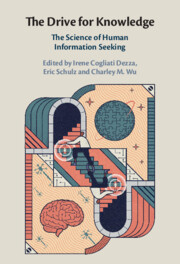Book contents
- The Drive for Knowledge
- The Drive for Knowledge
- Copyright page
- Contents
- Figures
- Tables
- Notes on Contributors
- Preface
- Part I What Drives Humans to Seek Information?
- Part II How Do Humans Search for Information?
- Part III Which Machinery Supports the Drive for Knowledge?
- Chapter 9 Information-Seeking in the Brain
- Chapter 10 Attention as Rational Choice
- Chapter 11 Seeking Inner Knowledge
- Chapter 12 Edgework
- Future Challenges
- Index
- References
Chapter 9 - Information-Seeking in the Brain
from Part III - Which Machinery Supports the Drive for Knowledge?
Published online by Cambridge University Press: 19 May 2022
- The Drive for Knowledge
- The Drive for Knowledge
- Copyright page
- Contents
- Figures
- Tables
- Notes on Contributors
- Preface
- Part I What Drives Humans to Seek Information?
- Part II How Do Humans Search for Information?
- Part III Which Machinery Supports the Drive for Knowledge?
- Chapter 9 Information-Seeking in the Brain
- Chapter 10 Attention as Rational Choice
- Chapter 11 Seeking Inner Knowledge
- Chapter 12 Edgework
- Future Challenges
- Index
- References
Summary
Recent advancements in psychology, behavioral economics, and neuroscience have shown the human pursuit of knowledge to be an essential aspect of human cognition. It drives intellectual development, is integral to social interactions, and is crucial for learning, decision-making, and goal-directed behavior. Information appears to be valuable in and of itself, even when it has no apparent use, whereas at other times, instrumental information is actively and paradoxically avoided. With this complex role, a wide range of neural mechanisms can be deployed to assign value to information and drive decisions to seek (or avoid) information. Evidence points toward key roles for the mesolimbic system and the prefrontal cortex in these processes. Specifically, two different networks appear to be involved in the implementation of information-seeking behaviors. One network, overlapping with areas involved in processing primary and monetary rewards, appears to drive a general preference for information, as well as valence-dependent information-seeking. The other network, independent of reward processing, is recruited when information is acquired to reduce uncertainty. In this chapter, we review some of the most recent discoveries in the field to provide an overview of the neural basis of information-seeking.
- Type
- Chapter
- Information
- The Drive for KnowledgeThe Science of Human Information Seeking, pp. 195 - 216Publisher: Cambridge University PressPrint publication year: 2022
References
- 2
- Cited by

